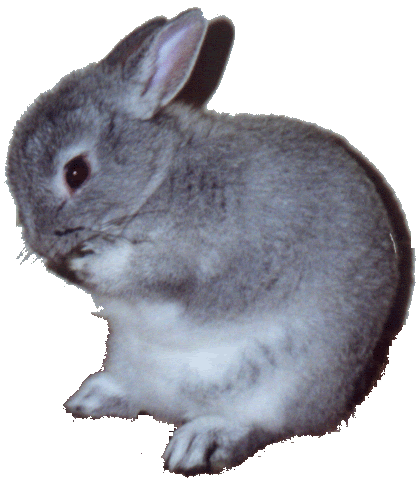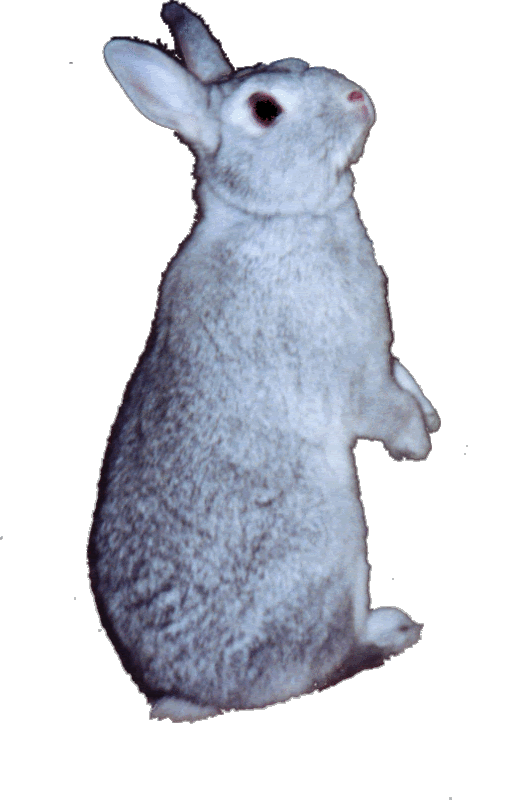

Interestingly, rabbits are “crepuscular”, that is, they prefer to be active in the morning, just after dawn, and at night, around dusk, preferring to rest in the middle of the day and the middle of the night. This “crepuscular” behaviour is great news for a human companion, since bunnies are at their most sociable when we are at home and most relaxed, particularly in the evenings, when we humans really get the opportunity to enjoy our bunnies’ company.
It is not just in your own interests to have your companion bunny indoors with you - it is also in the interests of, and far preferable for, your bunny, too. An outdoors rabbit will not only be less active than an indoors bunny, but considering rabbits’ sociability, he will also be very lonely … your rabbit will be much healthier and happier indoors with you, interacting with you, and will grow to consider you as his family, his “warren”, that is, his social group, who bunnies spend a lot of time interacting with; this is in contrast to a bunny’s “burrow”, which is his own personal space, his cage or hutch.
Furthermore, whenever an indoors rabbit becomes unwell, you will observe this immediately, in his changing behaviour - an indoors bunny’s increased interaction with you ensures that his illness or health will be observed and acted upon straight away. This is of course much preferable to the outdoors hutch rabbit, who only sees his humans a couple of times a day, and whose health or illness is often only spotted when it has become really severe.
Of course, an indoors bunny is also much safer, does not have to worry and stress about predators - both dangerous animal predators such cats, foxes, dogs, birds of prey such as kestrels and eagles and owls; or the sinister insects and bacterial predators, such as the deadly myxomatosis which can be so tragically spread via a mosquito or flea bite by any infected insect; or the really horrific fly-strike, which can kill a rabbit in just a few days, a result of the larvae of flies eating into the rabbit’s body, after blowflies lay their eggs on a poor unsuspecting and unprotected rabbit. Horrific tragedies such as these can obviously be watched for and avoided a lot more safely when your bunn lives indoors with you.
An indoors bunny needs to be protected as well, of course … most importantly, be careful to cover any electrical cords where your bunny may run, because bunnies have a dangerous penchant for chewing plastic and rubber. It is a good idea to lay down on the floor yourself, and take a look at your world from a bunny’s viewpoint, and remove any tempting chewable plastic and so on. Also be very careful to keep potted plants up high and well away from curious bunnies - many indoor plants are deadly poisonous to rabbits.
Pookie, our eight year old Netherland Dwarf bunny, lives inside our home with us (as have all our three bunnies). He lives in his “burrow”, his cage/hutch, on his own table, in the quietest corner of the lounge. And every evening he is free to run around the lounge for several hours (we close the doors, and block behind the couch with cushions, and cover all the electrical wires very well, of course, with cushions and rugs). During these daily runs, Pookie races up and down the room with happiness, often leaping through the air, binkying - this is when a bunny expresses his joy by leaping through the air and shaking his whole little body, from the tips of his ears to the tip of his tail!
Pookie’s “burrow”, his own personal space, is this cage in the corner of the lounge, the type which has a wire top, and a plastic base. We cover the base with thick newspaper, and then wood shavings, which you can buy at any pet shop, and which are also used for mice’s cages. We change the newspaper and wood shavings, and rinse out the plastic base, several times a week. We fit the entire plastic base with newspaper to the edges, and cover one corner, about one quarter of the newspaper floor of his cage, with the wood shavings, in the corner of his cage which he uses for his toilet - we leave at least two-thirds of the newspaper clear of shavings so that he can stretch out on the smooth paper. Another large corner of his cage is always tucked full of lucerne hay, which of course should be constantly available to all bunnies.
As mentioned, his “burrow” has a wire top, which has a side-door, so,
when we’re ready for him to come out into the loungeroom, we simply
carefully place his cage on the ground, open his side-door, and drape a
doubled-up towel well over the door’s metal bars, so that he will never
catch his feet in the wire. He then jumps up and races out himself,
extremely enthusiastically! After racing up and down the room a few times,
Pookie goes to his litter tray in the corner, and crouches there with a look
of concentration on his face, while he makes an important pile of “hraka”,
as they say in “Watership Down”.
Yes, rabbits can be toilet-trained … whether in his hutch, or free in
your home, you’ll notice that your bunny usually pees in the same corner.
So, get a flat tray - we cover Pookie’s litter tray with a couple of pages
of newspaper and more wood shavings - and put the tray directly where he’s
peeing. He then begins to associate the tray as the toilet. (Just a word
of warning - NEVER use mineral cat litter, because if a rabbit ingests
this, it can swell in his stomach and he will die. Much better are wood
shavings or shredded paper.) The trick is really to put the tray where you
observe him peeing, rather than try to get him to go wherever you place
the tray … that will not succeed! He will eventually associate the tray
with pooping as well, but this is relative to the individual bunny …
some bunnies are easier to toilet train than others, and you must remember
that, from a rabbit’s point of view, depositing a small pile of droppings,
and their regular corners where they pee also, reassures your bunny that
this is his territory, and that no other pesky renegade rabbits are
going to try and claim it as theirs. Anyway, bunnies’ pellet-like poop
isn’t very offensive, and is easy to sweep up! You can gather up the
pellets which bunny deposits around the room, and place them on his
litter tray - this will encourage him to recognise the tray as the place
to deposit them in future. But rabbits can indeed be toilet trained
because, to reiterate, they like to go in the one place … so when you
find the place that they like to go, that is where you place the tray,
and they will learn to associate the tray with their toilet. If they’re
also peeing in a different spot, especially in a large enclosure or a
big room, you simply place another, second tray in that new spot too -
so bunny may have two trays, in a larger enclosure or room.



